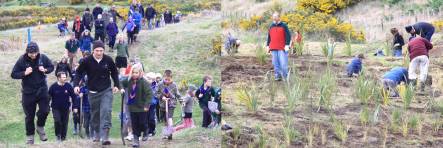Our Changing World for Thursday 16 September 2010
Music of the Stars
 Universityof Canterbury astronomers Peter Cottrell and Karen Pollard with astronomy stamps issued by New Zealand Post. (image: University of Canterbury)
Universityof Canterbury astronomers Peter Cottrell and Karen Pollard with astronomy stamps issued by New Zealand Post. (image: University of Canterbury)
Although modern telescopes are reaching closer and closer to the edge of the observable universe and the beginning of time, the inside of stars remains very difficult to explore. Yet, the interiors of stars are the crucibles for all known elements except hydrogen and helium.
One way to investigate the internal structure of stars and their evolution is to listen to their "music". Many stars, including our sun, vibrate like bells or a drum that has been struck. The pattern of surface vibrations depends on the internal properties of the star and as a result each star has a unique musical voice. University of Canterbury astronomers Karen Pollard and Peter Cottrell and PhD students Florian Maisonneuve and Emily Brunsden explain how the analysis of such tiny surface vibrations - a scientific discipline called asteroseismology - is used to deduce information about the stellar core. The team uses telescopes at the Mt John Observatory near Tekapo to observe stars and, in collaboration with other observatories, has set up an astereroseismic network to study the structure and evolution of several groups of pulsating stars.
During this interview, you can also hear original music composed by Hungarian astrophysicist Zoltan Kollath, who runs a project on stellar music.
Follow the links for other astronomy interviews: history of astronomy, white dwarfs, extra-solar planets, Square Kilometre Array, and super-massive black holes.
Care Group Tree Planting Celebration

Keen volunteers head out to plant 10,000 plants in a dune wetland in Queen Elizabeth Park (images: M. Velde/Greater Wellington)
When the Greater Wellington Regional Council decided to celebrate ten years of volunteer environmental projects by various Care Groups in and around the Wellington region, a massive tree planting seemed the obvious way to do it. Alison Ballance joined several hundred volunteers at Queen Elizabeth Park on the Kapiti Coast north of Wellington as they set about planting 10,000 trees to restore a dune wetland in the park. She talked with various keen volunteers, June Rowland about the history of restoration efforts in Queen Elizabeth Park, John Lancashire about the Friends of Queen Elizabeth Park, John McLachlan from the Kapiti-Mana branch of Forest and Bird, and Robyn Smith from Greater Wellington who co-ordinates the Take Care Programme.
Conservation Week and Island Bay Beach Clean Up

Wellington Lions rugby players and Ricoh staff show off the rubbish they picked up during a beach clean-up at Island Bay (image: M. Barnett/DoC)
Conservation Week runs from 12-19 September with the theme Love New Zealand Arohaina i a Aotearoa. And the Keep New Zealand Beautiful National Clean Up Week starts tomorrow until 24 September. To mark both occasions, Alison Ballance headed to Island Bay on Wellington's South Coast to join a corporate beach clean-up organised by the Department of Conservation. Taking part were half a dozen players from the Wellington Lions Rugby team, and a group from Ricoh New Zealand. They were joined by the Friends of Taputeranga Marine Reserve - the marine reserve borders the beach and recently celebrated its second birthday. With gloves on and rubbish bags in hand, the volunteers scoured the beach and nearby roadside reserve for rubbish which ranged in size and frequency from cigarette butts (numerous) to a foam mattress (one).
Psychology of Killing
 In Nazi Germany they called it Blutkitt or "blood cement" -- a way of binding people to a group by making them party to atrocities.
In Nazi Germany they called it Blutkitt or "blood cement" -- a way of binding people to a group by making them party to atrocities.
It appears to be an integral part of gang initiations worldwide, and the psychology behind it is the focus of University of Canterbury's Michael Richardson masters thesis.
Following on from work conducted by supervisor Andy Martens, participants are asked to put slaters into a modified coffee grinder (pictured left), and then directed to kill them.
To find out what these experiments have to do with gang initiations, Ruth Beran volunteers to be a guinea pig.